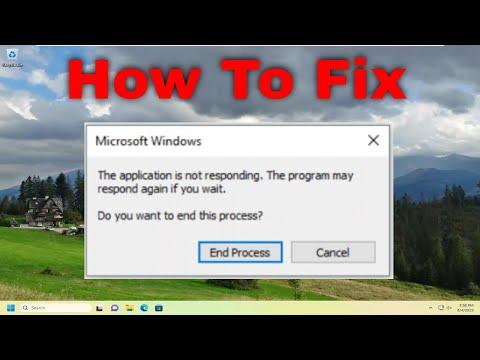I was deep into an important project on my Windows 11 laptop when suddenly, an application froze. The screen displayed the dreaded “Application Is Not Responding” message, and no matter what I did, the application wouldn’t close or resume. Frustration quickly set in as I realized that this wasn’t the first time this had happened. This issue was becoming a recurring nightmare, impacting my productivity and leaving me with a constant sense of dread whenever I launched certain applications.
Determined to tackle this issue once and for all, I began by examining the problem closely. I noticed that the error seemed to occur sporadically with different applications, both built-in and third-party. My initial thought was that it could be related to recent updates or software conflicts. I started my troubleshooting process by focusing on some fundamental checks and solutions.
First, I checked for updates. I navigated to the Windows Update section in the Settings app and ensured that my operating system was fully up-to-date. Sometimes, application issues arise due to outdated system components, and applying the latest updates could resolve such problems. After installing all pending updates and restarting my laptop, I hoped this would solve the issue, but unfortunately, the problem persisted.
Next, I turned my attention to the specific applications causing trouble. I noticed that some of them had recent updates or changes in their settings. I decided to try updating these applications to their latest versions. I visited the official websites of these applications or used their built-in update mechanisms to ensure they were running the most recent versions. Despite this, the error continued to plague me, which led me to consider other possibilities.
It was time to delve deeper into the problem. I performed a clean boot of my system to identify if any third-party software or startup items might be causing the conflict. A clean boot starts Windows with a minimal set of drivers and startup programs. I accessed the System Configuration tool by typing “msconfig” into the search bar and selected the “Selective startup” option. I unchecked the “Load startup items” checkbox and restarted my laptop. This step helped me determine if any non-essential startup programs were causing the issue.
During the clean boot, I observed that the application did not freeze. This suggested that a background program or service might be the culprit. To pinpoint the specific program, I gradually re-enabled startup items and services, restarting my laptop each time, until the issue reappeared. This process allowed me to identify the conflicting application or service, which I then proceeded to disable or uninstall.
Another approach I tried was repairing or reinstalling the problematic applications. I accessed the “Apps & features” section in the Settings app, selected the application that was misbehaving, and chose the “Modify” option. Some applications offer a repair option that can fix issues without requiring a full reinstall. After repairing the application, I restarted my laptop and tested the application to see if the problem was resolved.
If repairing didn’t work, I uninstalled the application completely and reinstalled it from scratch. This process involved removing all residual files and settings related to the application to ensure a clean installation. After reinstalling, I was hopeful that the application would function correctly, but I remained cautious.
Furthermore, I checked my system’s resource usage. Sometimes, high CPU or memory usage can cause applications to become unresponsive. I used the Task Manager to monitor resource consumption and identified any processes that were using excessive resources. If I found any, I closed unnecessary applications or processes to free up resources. This often improved overall system performance and stability.
I also considered the possibility of corrupted system files. To address this, I ran the System File Checker tool by opening Command Prompt as an administrator and typing the command sfc /scannow. This tool scans and repairs corrupted system files that might be causing application errors. The scan found and repaired some issues, which provided me with hope for a solution.
Lastly, I explored the option of creating a new user profile. Sometimes, issues with the user profile can lead to application errors. I created a new user account through the “Family & other users” section in Settings and logged in with this new profile. If the application worked fine under the new user account, it indicated that the problem was related to the original user profile. In such cases, transferring my data to the new profile often resolved the issue.
In conclusion, addressing the “Application Is Not Responding” error on Windows 11/10 required a multi-faceted approach. By updating the system and applications, performing clean boots, repairing or reinstalling problematic applications, managing system resources, checking for corrupted files, and potentially creating a new user profile, I was able to troubleshoot and resolve the issue. Each step was a piece of the puzzle, leading me to the ultimate solution and restoring my productivity.
